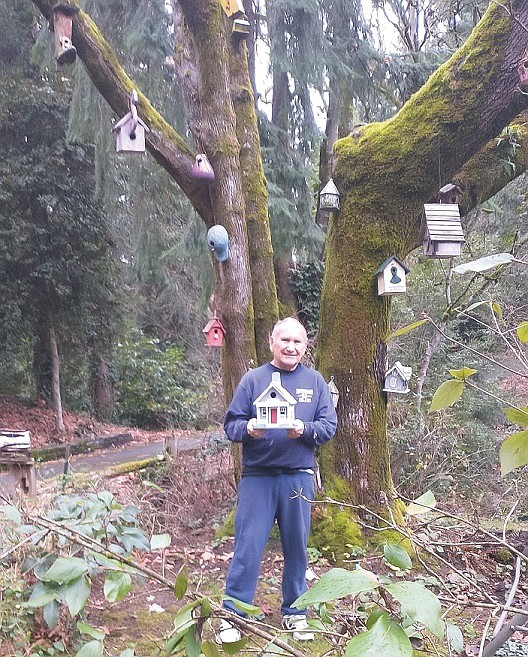Birdwatching Basics
The Great Outdoors
February 27, 2022 at 12:00 a.m.
...by ...by Roger Urbaniak
If you are looking for a fun new hobby and enjoy being outdoors, try birdwatching. Needed equipment is minimal and relatively inexpensive, mostly consisting of binoculars and at least one bird ID book. Once started, you will find it a fun hobby that can last you a lifetime.
Keeping track of the different birds that you’ve seen can make birdwatching more enjoyable and improves your identification skills. Consider contacting your local chapter of the Audubon Society to share your hobby with others. Experienced birders can suggest viewing areas to spot those hard-to-find species.
Once you start getting good at birdwatching, many birds can be recognized by their distinct species calls, which will help guide you where to look.
Some birdwatchers recommend logbooks to categorize your sightings to fit your lifestyle. These categories might include local birds, yearly sightings, trips, species you still need to look for, birds of prey, migrations, game birds or other listings that fit your activity. You may even find yourself planning vacations that fit in with your hobby.
We have taken trips to Nebraska to see sandhill cranes during peak migration. We also treated ourselves to the services of a local guide who took us to view prairie chickens and sharp tail grouse perform mating dances on their chosen lek site. His promise of getting us close enough to take photos of the rituals turned out to be both accurate and exciting. Driving to Boise to tour the World Center for Birds of Prey was informative and enjoyable. If you time your tour right, you might see a falcon capture prey as part of the Center’s program.
March 19th is when the swallows return to Mission San Juan Capistrano in California, as they have for 100 years. Don’t forget to mark the date on your calendar—it’s a great time of year to travel.
Seeing birds at home can be interesting. We’ve made our backyard bird-friendly. We don’t use pesticides and have plants that support birds. Several organizations, including the National Wildlife Federation, Audubon Society and Washington State’s Habitat at Home program, certify properties that meet basic requirements.
Back yard bird-feeding is not without its downside. Squirrels and rats tend to enjoy the food put out for birds, so make sure you protect it with metal containers when stored outside. Wasps enjoy sugar from hummingbird feeders, so make sure you wipe up and/or dilute any spills. And your fishpond will likely be raided. Even our local barred owl was seen carrying off a snack. Once a blue heron or kingfisher locate your goldfish, you can plan on frequent trips to a pet store to keep your pond stocked. Keep in mind that most birdhouses need to be cleaned out once a year to keep them safe for the birds.
Soon your new hobby will allow you to impress your neighbors with expressions like “Did you see that Spotted Towhee yesterday?”
Want more outdoor articles? Visit Roger’s website at WWW.rogersoutdoorchannel.com.
Keeping track of the different birds that you’ve seen can make birdwatching more enjoyable and improves your identification skills. Consider contacting your local chapter of the Audubon Society to share your hobby with others. Experienced birders can suggest viewing areas to spot those hard-to-find species.
Once you start getting good at birdwatching, many birds can be recognized by their distinct species calls, which will help guide you where to look.
Some birdwatchers recommend logbooks to categorize your sightings to fit your lifestyle. These categories might include local birds, yearly sightings, trips, species you still need to look for, birds of prey, migrations, game birds or other listings that fit your activity. You may even find yourself planning vacations that fit in with your hobby.
We have taken trips to Nebraska to see sandhill cranes during peak migration. We also treated ourselves to the services of a local guide who took us to view prairie chickens and sharp tail grouse perform mating dances on their chosen lek site. His promise of getting us close enough to take photos of the rituals turned out to be both accurate and exciting. Driving to Boise to tour the World Center for Birds of Prey was informative and enjoyable. If you time your tour right, you might see a falcon capture prey as part of the Center’s program.
March 19th is when the swallows return to Mission San Juan Capistrano in California, as they have for 100 years. Don’t forget to mark the date on your calendar—it’s a great time of year to travel.
Seeing birds at home can be interesting. We’ve made our backyard bird-friendly. We don’t use pesticides and have plants that support birds. Several organizations, including the National Wildlife Federation, Audubon Society and Washington State’s Habitat at Home program, certify properties that meet basic requirements.
Maintaining our goldfish pond offers water to the thirsty and it occasionally provides food for the hungry. We offer birdfeeders including suet, seed and hummingbird feeders. We also feature an actual birdhouse tree with over 20 different style birdhouses available. We are fortunate to have lots of flowers and trees, plus a ravine to attract a wide variety of birds.
Back yard bird-feeding is not without its downside. Squirrels and rats tend to enjoy the food put out for birds, so make sure you protect it with metal containers when stored outside. Wasps enjoy sugar from hummingbird feeders, so make sure you wipe up and/or dilute any spills. And your fishpond will likely be raided. Even our local barred owl was seen carrying off a snack. Once a blue heron or kingfisher locate your goldfish, you can plan on frequent trips to a pet store to keep your pond stocked. Keep in mind that most birdhouses need to be cleaned out once a year to keep them safe for the birds.
Soon your new hobby will allow you to impress your neighbors with expressions like “Did you see that Spotted Towhee yesterday?”
Want more outdoor articles? Visit Roger’s website at WWW.rogersoutdoorchannel.com.





